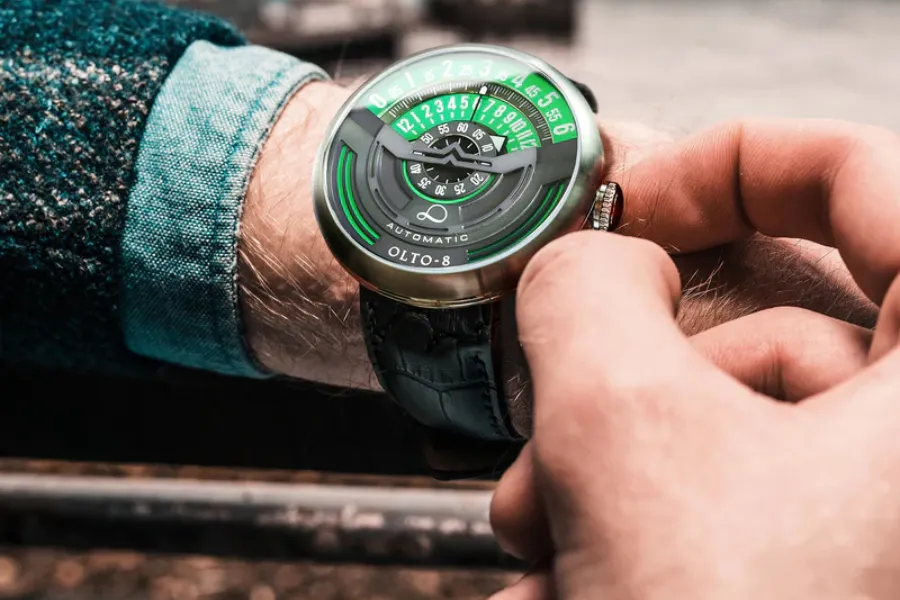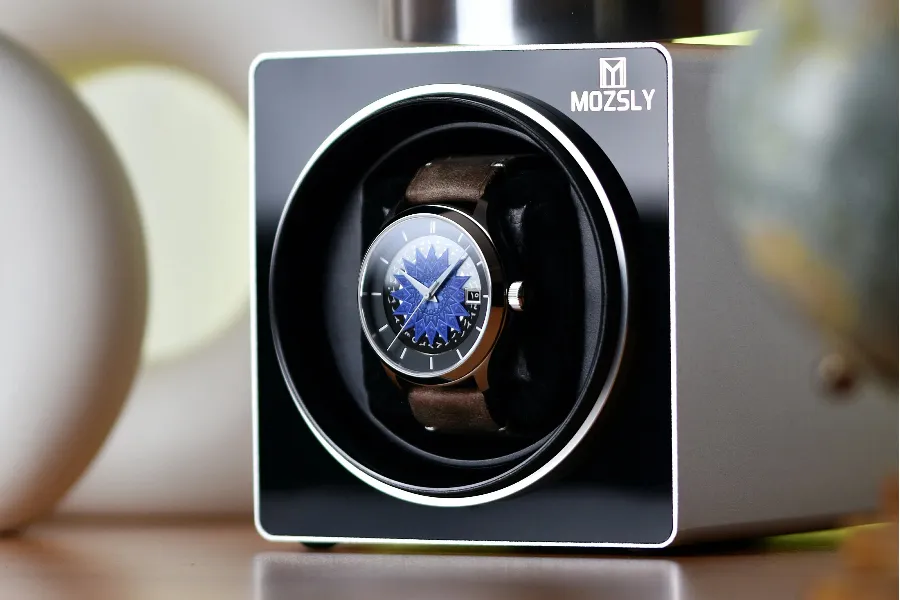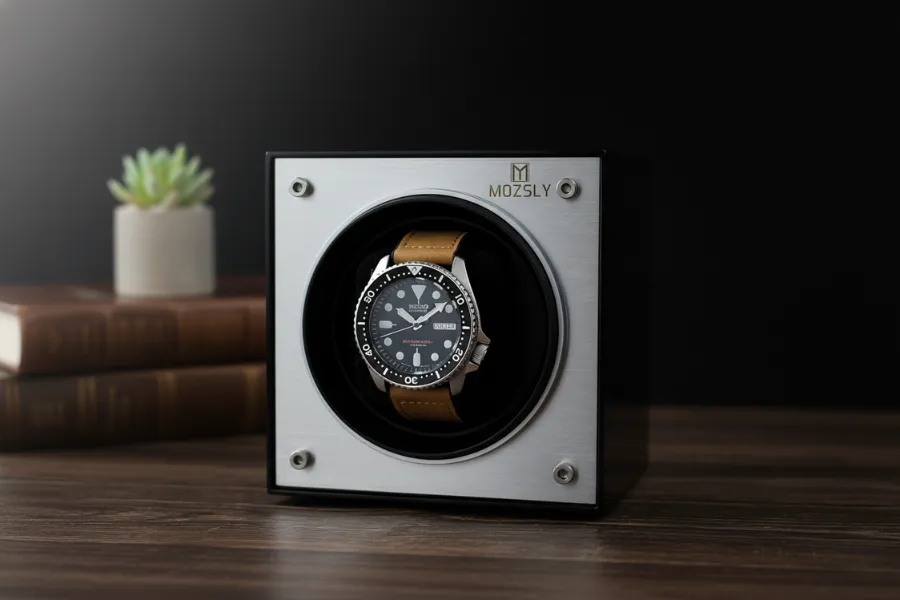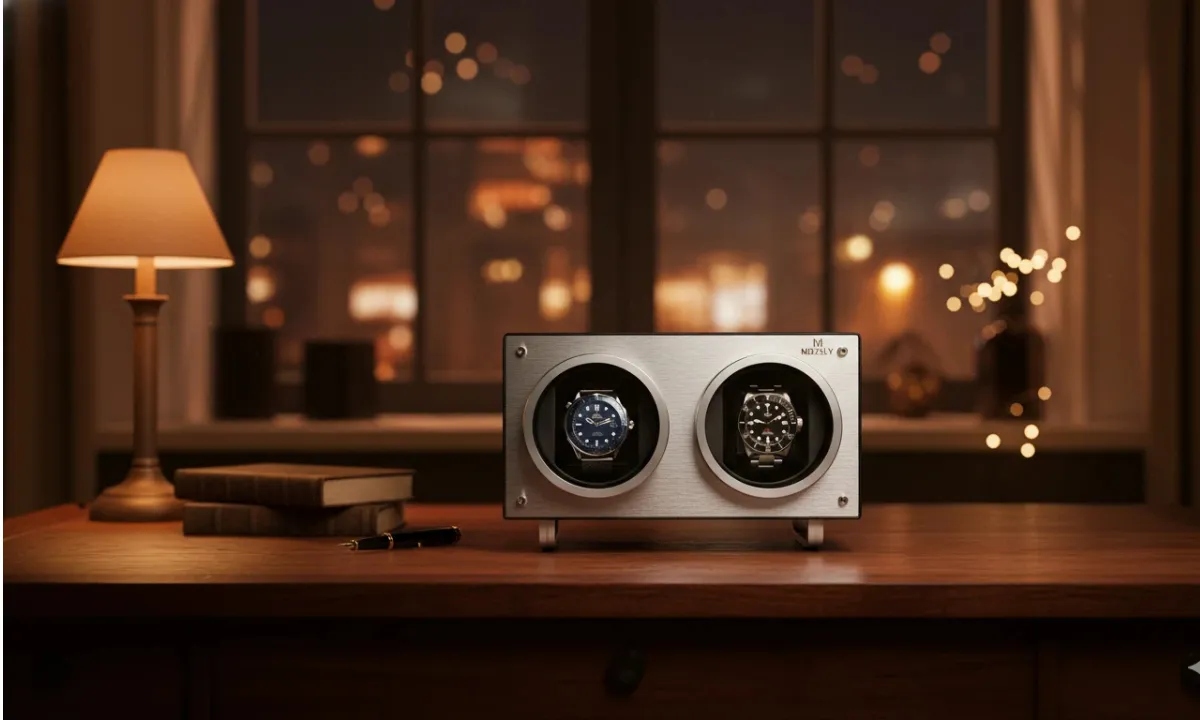Share This Post
- Quick note on how automatic watches work
- The Automatic Watch Debate: Running vs. Stopped Storage
- Do You Really Need a Watch Winder?
- How to Choose the Right Watch Winder (Practical Tips)
- Why I Use the Mozsly Watch Winder
- Other Effective Methods for Storing Automatic Watches
- Protecting Your Automatic Watch in Storage Method
- Your Automatic Watch Storage Decision Guide
- Final Recommendations and Next Steps
Automatic Watch Storage Dilemma

automatic watch
Quick note on how automatic watches work
The Automatic Watch Debate: Running vs. Stopped Storage
Benefits of Keeping Your Automatic Watch Running
- No resetting complicated functions. Annual calendars or moon phases are a pain to reset. A running automatic watch skips the hassle.
- Convenience. If you rotate 2–3 watches, a running automatic watch is ready the moment you reach for it.
- Lubricants stay distributed. Movement helps oils stay where they should.
Benefits of Letting Your Automatic Watch Stop
- Less mechanical wear. Fewer cycles = less friction over time.
- Longer service intervals. Many people move from 3–5 years of service to 5–7 years for lightly used pieces.
- Lower maintenance costs. That can save a few hundred dollars over time, depending on the watch and the shop.
Do You Really Need a Watch Winder?
Ask yourself:
- How many automatic watches do you own?
- How often do you wear each one?
- Do any have annual or perpetual calendars?
- Do you travel frequently and want your watches that are ready to wear?
When a Watch Winder Makes Sense
- You have them with annual or perpetual calendar complications; resetting those complex functions can cost approximately $50–$100 or more.
- You travel a lot and want it ready the moment you land.
- You collect vintage pieces that benefit from gentle, regular movement.

watch winder
When You Can Skip the Watch Winder
- You own one, or you wear it most days.
- Your watch is a simple time-and-date model.
- You wear it only on weekends.
- Your budget is tight (under about $200).
How to Choose the Right Watch Winder (Practical Tips)
Essential Features That Actually Matter
- TPD stands for Turns Per Day, meaning how many times the watch winder spins your watch each day. Most automatic watches need about 650–900 TPD to stay fully wound.
- Rotation directions: Some movements require clockwise rotation, some counterclockwise, and some require both. A bi-directional mode works for most them.
- Quiet operation: if it sits in your bedroom, low noise is important.
- Power options: an AC adapter plus battery backup is ideal.
Why I Use the Mozsly Watch Winder

my watch winder
The reasons:
- The TPD range covers ~650–1500, so it works with most movements.
- Uses quiet Japanese Mabuchi motors — good for bedroom use.
- Dual power: AC adapter plus battery option.
- The price ranges from $100 to $200, while many premium brands cost $400 or more.
Setting Up Your Mozsly Watch Winder for Best Results
- Secure the watch on the cushion.
- Start at 650 TPD and in bi-directional mode.
- Run for 48 hours and check timekeeping.
- If it gains/loses too much, adjust TPD in 100–200 steps.
Troubleshooting quick tips:
- Watch not winding: check the pillow fit and try different rotation directions.
- Excessive noise: place the winder on a stable surface and tighten any loose parts.
- Power problems: use AC power first; batteries are for backup.
Other Effective Methods for Storing Automatic Watches
Traditional Watch Boxes and Cases
- Protects from dust and scratches.
- Keeps watches organized.
- Easy to store or travel with.
- No winding. You’ll need to set them manually.
Simple Storage Solutions for Every Budget
- Watch pouches ($5–$15): affordable, travel-friendly.
- Soft cases ($10–30): better padding for trips.
- Cushioned drawers ($30–80): great for a small home collection.
Protecting Your Automatic Watch in Storage Method
Environmental Factors and Positioning
- Temperature: 65–75°F (18–24°C).
- Humidity: 40–60%.
Common Storage Mistakes to Avoid
- Store automatic watches next to speakers, phones, or magnets — they can interfere with the movement.
- Leave your watches in a hot car or attic — heat can damage seals and oils.
- Stack automatic watches without padding — they’ll scratch.
Your Automatic Watch Storage Decision Guide
- Do you own 2+ automatic watches?
Yes → Consider a watch winder, especially if you rotate often.
No → Basic storage or manual winding will work fine.
- Any annual/perpetual calendars?
Yes → A watch winder helps avoid complex resets.
- Do you travel and want them ready immediately?
Yes → A watch winder makes life easier.
- Budget under $80 and occasional use?
Yes → Skip the watch winder; use a box or pouch.
Final Recommendations and Next Steps
Quick recap:
- If convenience and ready-to-wear matter, a watch winder is worth it.
- If you want to save money and wear your automatic watch often, a manual winding mechanism and a good box are fine.
- For most collectors who frequently rotate their automatic watches, a reliable and wonderful Mozsly watch winder is a balanced choice.
What to do next:
- Decide based on three factors: the number of them you own, the complexity of their complications, and the frequency with which you wear them.
- If you buy a watch winder, start at 650 TPD and bi-directional mode for 48 hours, then fine-tune.
- If you skip using a watch winder, use a padded box or pouch and wind your watch manually before wearing it.
- Where to buy: look for the Mozsly watch winder on reputable marketplaces or the brand site. For automatic watch winder boxes, pick sellers with good return policies.
- What to avoid: cheap knockoffs with loud motors, extreme storage locations, and stacking them without protection.
Related Post's
Featured Video
Provide an email subscription feature for users to sign up for updates.
Follow the world of watches and cigars for exclusive content!
By subscribing to our newsletter, you will be the first to receive notifications of our latest articles, popular posts and special events.





